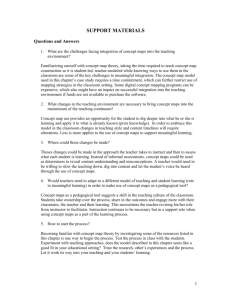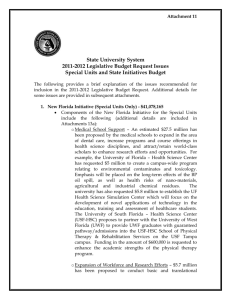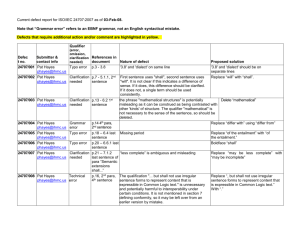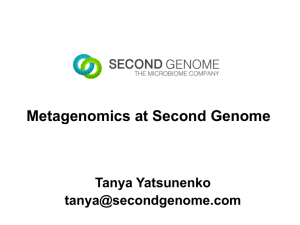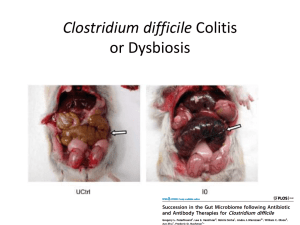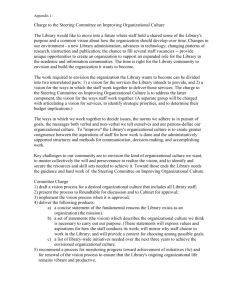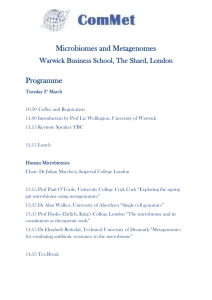Proposal for the International Cancer Genome Consortium
advertisement
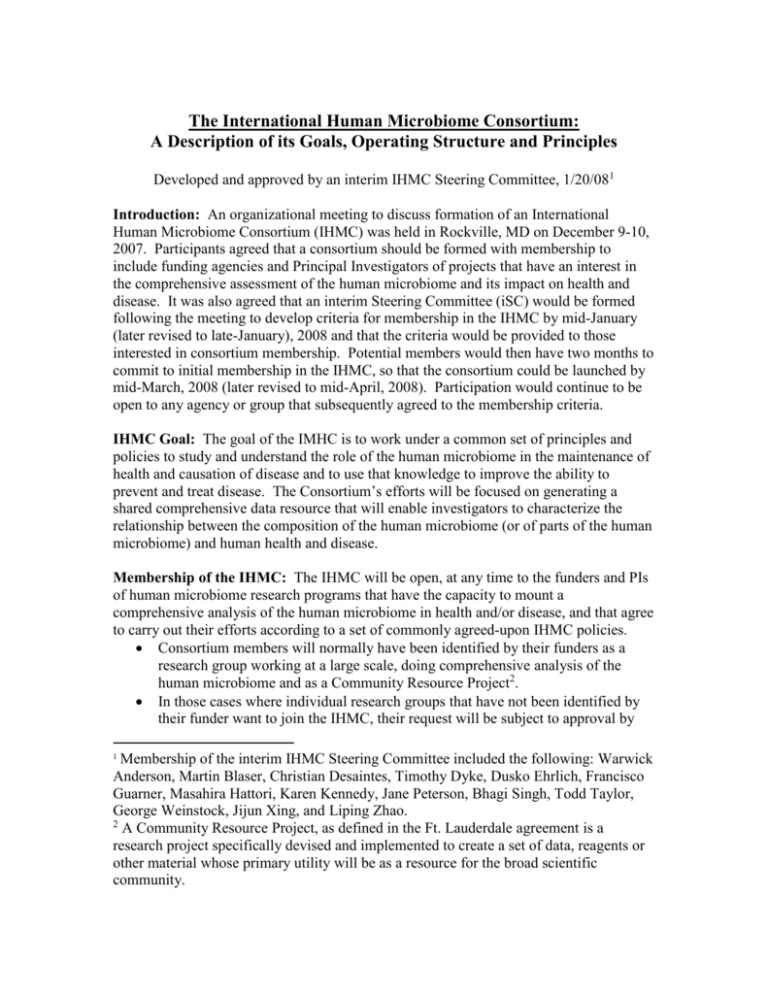
The International Human Microbiome Consortium: A Description of its Goals, Operating Structure and Principles Developed and approved by an interim IHMC Steering Committee, 1/20/081 Introduction: An organizational meeting to discuss formation of an International Human Microbiome Consortium (IHMC) was held in Rockville, MD on December 9-10, 2007. Participants agreed that a consortium should be formed with membership to include funding agencies and Principal Investigators of projects that have an interest in the comprehensive assessment of the human microbiome and its impact on health and disease. It was also agreed that an interim Steering Committee (iSC) would be formed following the meeting to develop criteria for membership in the IHMC by mid-January (later revised to late-January), 2008 and that the criteria would be provided to those interested in consortium membership. Potential members would then have two months to commit to initial membership in the IHMC, so that the consortium could be launched by mid-March, 2008 (later revised to mid-April, 2008). Participation would continue to be open to any agency or group that subsequently agreed to the membership criteria. IHMC Goal: The goal of the IMHC is to work under a common set of principles and policies to study and understand the role of the human microbiome in the maintenance of health and causation of disease and to use that knowledge to improve the ability to prevent and treat disease. The Consortium’s efforts will be focused on generating a shared comprehensive data resource that will enable investigators to characterize the relationship between the composition of the human microbiome (or of parts of the human microbiome) and human health and disease. Membership of the IHMC: The IHMC will be open, at any time to the funders and PIs of human microbiome research programs that have the capacity to mount a comprehensive analysis of the human microbiome in health and/or disease, and that agree to carry out their efforts according to a set of commonly agreed-upon IHMC policies. Consortium members will normally have been identified by their funders as a research group working at a large scale, doing comprehensive analysis of the human microbiome and as a Community Resource Project2. In those cases where individual research groups that have not been identified by their funder want to join the IHMC, their request will be subject to approval by Membership of the interim IHMC Steering Committee included the following: Warwick Anderson, Martin Blaser, Christian Desaintes, Timothy Dyke, Dusko Ehrlich, Francisco Guarner, Masahira Hattori, Karen Kennedy, Jane Peterson, Bhagi Singh, Todd Taylor, George Weinstock, Jijun Xing, and Liping Zhao. 2 A Community Resource Project, as defined in the Ft. Lauderdale agreement is a research project specifically devised and implemented to create a set of data, reagents or other material whose primary utility will be as a resource for the broad scientific community. 1 IHMC Proposal the IHMC Steering Committee. They will initially be Adjunct Members and become full Members once they have demonstrated that they are abiding by the principles of the IHMC. Initially, funders who do not have funded programs in place but anticipate they will fund a program that will adhere to these principles in the next 18 month will be an Observer Member of Steering Committee without a vote until their research programs are funded. Role of the IHMC: The role of the IHMC will be to coordinate the activities and policies of the international groups studying the human microbiome to promote the generation of a robust, data resource that is freely available to the scientific community and that can be analyzed across many groups. The IHMC will undertake to ensure that large-scale, genomic analysis projects will accelerate progress in human microbiome research and contribute to development of a robust data set that will advance future studies of the human microbiome in health and disease by scientists around the world. The IHMC will also facilitate the adoption of informed consent and recruitment standards, quality standards and data deposition and release policies that will make high quality data available to the entire research community as rapidly as possible. Other functions of the IHMC will include the coordination of research efforts, so that the interests and priorities of individual participants, funding agencies and nations will be addressed and so that unnecessary redundancy in human microbiome research will be minimized. Proposed Organization of the IHMC: The primary working organizations within the IHMC will be a Steering Committee (SC) and a Funders Committee (FC). The SC will be comprised of representatives of each of the participating funding agencies and/or organizations and the Principal Investigators leading projects in the IHMC. The Steering Committee will vote on issues if a consensus cannot be reached in an IHMC discussion. Each funding agency will have at least one member and at least one PI from its research project on the SC, with large, multi PI consortia having more than one as agreed on by the Funders Committee (FC). The FC membership will be made up of one representative from each funding agency. Additional members of the funding agencies and the research projects will participate in the face to face Steering Committee meetings and on conference calls. Working groups of the SC may be formed to carry out more in-depth analyses of issues/policies that arise in the course of the human microbiome projects. These working groups will be made up of experts in the technology/scientific issue/policy under discussion, and will not have to be participants in a project included under the auspices of the IHMC. Initially, an interim SC (iSC) will be formed. The iSC will be composed of funders from Australia (CSIRO), Canada (CIHR, Genome Canada), China (MOST), the European Union (European Commission), Singapore, United States (the NIH) and investigators nominated by each of those funders. Drs. Jane Peterson (NIH) and Christian Desaintes (EC) will serve as interim co- chairs of the iSC and provide Secretariat functions. The iSC will develop a set of principles for membership in the IHMC (see below), and will 2 IHMC Proposal subsequently review applications for membership in the IHMC to decide if they meet the agreed-upon criteria. Principles for membership in the IHMC 1. Data release a. Projects participating in the IHMC are Community Resource Projects, as defined by the Fort Lauderdale principles (see meeting report at http://www.genome.gov/10506537). b. Members of the IHMC will agree to immediate release of verified (technically accurate) sequence data from isolated microorganisms or metagenomic data from samples taken from healthy and/or diseased individuals in an appropriate public database. c. Other types of data, such as gene expression, proteomic or metabolomic data that might be generated in projects carried out under the auspices of the IHMC are likely not to have such well-defined quality standards as sequence data. A working group will be established as soon as the IHMC Steering Committee is formed to define the minimal quality standards for such data to allow a definition of what “verified” data are. Once the data quality standards are approved by the SC, members of the IHMC will agree to immediate release of data verified according to the standards agreed to into an appropriate public database. d. Some IHMC project data, specifically decoded individual-level data, will be deposited in a controlled access database with the goal of maintaining the most widespread accessibility consistent with subject consent and with the submitter’s local regulatory requirements. Access to some of the individual-level data by investigators, working groups or networks may be subject to local or regional ethical considerations. A working group will be established to explore the possibilities of harmonizing the various international, national or regional ethical authorizations needed to allow the release of de-identified clinical data. e. Some large microbiome projects may have small components that do not fit the description of a Community Resource Project. An example of such a component is one that is studying the specific function of certain aspects of the microbiome, such as the role of specific genes. Each project requesting IHMC membership will need to describe all its components and the arguments for why a particular component should not be considered a Community Resource Project. The SC will decide whether it is comfortable with the project’s request to join the IHMC under the structure proposed by the project. A small component found not to be a Community Resource Project (and therefore is not part of the IHMC) will not participate in IHMC activities as its interests are separate. 3 IHMC Proposal 2. Intellectual Property. IHMC members will agree to discourage the filing of IP claims on pre-competitive, basic data of the type produced by a Community Resource Project. For example, sequence or expression data from a bacterial metagenomic study is considered to be precompetitive but data from follow up studies of the functional role of the metagenomic bacterial community or individual bacteria in that community are not and it would be acceptable to file for appropriate findings. 3. Publication a. The Ft. Lauderdale agreement was intended to promote rapid data release from a Community Resource Project to the scientific community, while also supporting the ability of the investigators carrying out the large-scale data production efforts, in this case IHMC members, to publish the first global analysis of their own data. The agreement addressed these dual goals by encouraging the members of the scientific community who used the pre-publication data sets to act responsibly and to follow high standards of respect for the contributions of the data generators. The IHMC Steering Committee will consider whether further steps are needed to protect the data producers’ interests, but will be mindful of the need to maximize public benefit by minimizing barriers to data access. b. The Steering Committee will consider publication of a “marker paper” that describes the project and informs the research community about the IHMC’s goals, membership guidelines, and data release and publication policies. c. The IHMC will contact journal editors to encourage them to act in accord with the data release guidelines and principles for IHMC publications. As a further step, the IHMC will consider drafting a letter of attestation that would accompany journal submissions affirming that the authors have properly consulted with the data producers, are not violating any community ethic regarding publication of their analysis and have properly acknowledged the data producers in their manuscript. This letter would be made available to the journals and microbial research community for their use. 4. Quality assessment a. Members of the IHMC agree that a quality assessment program is needed to ensure that the data produced by the Consortium are of high quality. b. As well as defining minimal standards for the quality of IHMC data, the Steering Committee will discuss development of a quality assessment plan for the Consortium to ensure that data produced adhere consistently to these standards. 5. Standards for consent of participants a. Members of the IHMC agree that proper informed consent of sample donors, in accord with local, national and international ethical guidelines and norms, must be obtained for all IHMC projects in which samples are obtained from human volunteers. 4 IHMC Proposal b. Members of the IHMC are willing to share their SOPs for donor recruitment and consent. The Steering Committee will serve as a forum for discussion of any differences in consent and protocols. A working group will be formed to discuss a process for how and where this information will be shared and posted. Funding: Participants in the IHMC will obtain their own funding for data generation and specimen collection. Implementation: The participants in the IHMC organizational meeting agreed that the iSC will establish an initial set of policies and standards for the Consortium, but specific research projects likely will be organized and driven by the established human microbiome research communities, and by national funding policies. Once the SC is formed it will provide a framework for coordinating and monitoring of IHMC projects. It is likely that creative and highly flexible approaches will be required. The iSC will present the proposed principles for IHMC membership to the international community by late January 2008. Funders and the groups that they support that are interested in membership will be asked to describe their activities and address how they will adhere to the principles described above. Funding or governmental organizations will be given six weeks to decide whether or not to become the initial members of the IHMC (with an understanding that the opportunity for membership will remain open to provide additional time for decision-making, to stage peer-reviewed competitions, or for the development of subsequent interest). It is the goal of the iSC to establish the IHMC with a fully functioning Steering Committee by the mid-April 2008. Initial Activities of the IHMC Steering Committee: Once formed, the IHMC steering committee should develop a set of guidelines for conference calls and face-to-face meetings to carry out its work. Tentatively, the SC will hold its first conference call shortly after the mid-April 2008 kickoff. The attendees at the organizational meeting identified the following as issues that the SC should consider, using working groups when appropriate: Strain selection and coordination for complete genome sequencing projects; Quality assessment; Data access, release, and consent; Publication; Intellectual property; Requirements of and plans for a web site or portal for sharing information among members and the scientific community. 5
